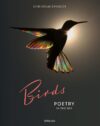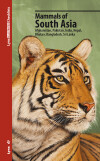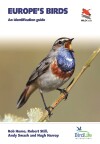It’s always a great day when Princeton University Press releases its catalog of upcoming natural history books. Or even just offers a preview, like today. Here are some books to look forward to in the first half of next year:
-
How to Be a Better Birder
Derek Lovitch
May, 2012
This unique illustrated handbook provides all the essential tools you need to become a better birder. Here Derek Lovitch offers a more effective way to go about identification—he calls it the “Whole Bird and More” approach—that will enable you to identify more birds, more quickly, more of the time.
He demonstrates how to use geography, an understanding of habitats, ecology, and even the weather to enrich your birding experience and find something out of the ordinary. Lovitch shows how to track nocturnal migrants using radar, collect data for bird conservation, discover exciting rarities, develop
patch lists—and much more. This is the ideal resource for intermediate and advanced birders. Whether you want to build a bigger list or simply learn more about birds, How to Be a Better Birder will take your birding skills to the next level.
-
Cotingas and Manakins
Guy M. Kirwan and Graeme Green
March, 2012
Cotingas and Manakins is the definitive work on these jewels of the Neotropics, covering more than 130 species. These range from some of the rarest and most enigmatic birds in the world to some of the best studied of all tropical species. Many are breathtakingly colorful and ornate while some are plain and difficult to see. This stunning volume features 34 color plates by Eustace Barnes, who has observed many of these species in the field, as well as distribution maps and approximately 400 color photographs that cover all but a tiny handful of species. Complete with detailed species accounts describing key identification features, Cotingas and Manakins is the
authoritative illustrated guide to these magnificent Neotropical birds.
-
A Field Guide to the Birds of New Zealand
Julian Fitter and Don Merton
January, 2012
New Zealand is commonly described as “the land of birds.” Now, there is an easy-to-use guide for all those interested in this country’s remarkable bird
population. A Field Guide to the Birds of New Zealand contains over 600 stunning photographs of the more than 350 bird species likely to be seen in this area of the world. Comprehensive and compact, the book includes full descriptions of all native species and regular visitors, distribution maps and measurements, key information on national parks, and useful information
on ongoing conservation efforts in the country. Filled with handy tips for nature enthusiasts wanting to make the most of their trip, this is the only bird guide that anyone exploring this region will need.
-
Birds of India, Pakistan, Nepal, Bangladesh, Bhutan, Sri Lanka, and the Maldives: second edition
Richard Grimmett, Carol Inskipp, and Tim Inskipp
March, 2012
The best field guide to the birds of the Indian subcontinent is now even better. Thoroughly revised, with 73 new plates and many others updated or repainted, the second edition of Birds of India now features all
maps and text opposite the plates for quicker and easier reference. Newly identified species have been added, the text has been extensively revised, and all the maps are new. Comprehensive and definitive, this is the indispensable guide for anyone birding in this part of the world.
-
Birds of Central Asia: Kazakhstan, Turkmenistan, Uzbekistan,
Kyrgyzstan, Tajikistan, Afghanistan
Raffael Ayé, Manuel Schweizer, and Tobias Roth
March, 2012
Central Asia—a vast and remote area of steppe, semi-desert, and mountains separating Europe from eastern Asia—is home to a diversity of birds. Birds of Central Asia is the first-ever field guide to the avian population for this fascinating part of the world. From ground jays, larks, and raptors, to warblers, nuthatches, and snowfinches, this comprehensive guide covers 627 species—including all residents, migrants, and vagrants—and 141 superb plates depict every species and many distinct plumages and races. The portable book contains important introductory sections on the land and its birds, and up-to-date color maps. The concise, authoritative text on facing pages
highlights key identification features, such as status, voice, and habitat. Birds of Central Asia is indispensable for anyone interested in the birds of this remarkable and little-known region.
-
Birds of Aruba, Curaçao, and Bonaire
Bart de Boer, Eric Newton, and Robin Restall
March, 2012
Located in the southern Caribbean off the coast of Venezuela, the islands of Aruba, Curaçao, and Bonaire are home to a colorful diversity of bird species. Birds of Aruba, Curaçao, and Bonaire is the first comprehensive field guide to the birds of the region and the ideal companion for identifying the islands’ remarkable avian population. The compact and portable book contains close to 1,000 superb color illustrations on 71 color plates and detailed descriptions of every species. Concise text on facing pages highlights key identification features, including voice, habitat,
behavior, and status. This field guide is essential for all birdwatchers and wildlife enthusiasts interested in this part of the world.
-
Birds of Melanesia: Bismarcks, Solomons, Vanuatu, and New Caledonia
Guy Dutson
March, 2012
Melanesia harbors an amazing range of endemic bird species and subspecies, many of which are poorly known. Birds of Melanesia is the first comprehensive field guide to all 501 species found in the Bismarck
Archipelago, Bougainville, the Solomons, Vanuatu, and New Caledonia. This beautifully illustrated guide features 86 color plates that depict almost every
species—including many endemic subspecies—and many of the plates are arranged by island group for easy reference. Detailed species accounts describe
key identification features and distribution, as well as key features for all subspecies. Distribution bars are also given for all species except extreme vagrants.
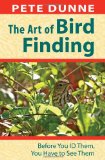 The Art of Bird Finding: Before You ID Them, You Have to See Them
The Art of Bird Finding: Before You ID Them, You Have to See Them
by Pete Dunne
Stackpole Books; Paperback; $14.95
From the publisher:
Filling a gap in the vast literature on birding, Pete Dunne explains in his distinctive style how to find birds – the often-ignored first step in identifying, observing, and listing bird species.
- The best strategies for locating birds in any season and in every kind of weather
- Techniques and expert advice applicable to species in habitats and environments throughout North America
- For beginning bird-watchers or experienced birders who want to improve their chances for success
I tried to resist, but had to jump right into this book. It’s Pete Dunne, after all! I’m not quite half-way through this short (96 pages) book, but have to say that it should prove a godsend for newer birders. I haven’t reached the more advanced stuff, but I bet there will be something here for any birder (besides Dunne’s fantastic writing).
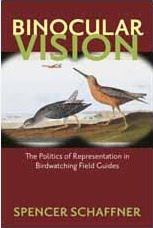 Binocular Vision: The Politics of Representation in Birdwatching Field Guides
Binocular Vision: The Politics of Representation in Birdwatching Field Guides
by Spencer Schaffner
From the publisher (University of Massachusetts Press):
From meadows to marshlands, seashores to suburbs, field guides help us identify many of the things we find outdoors: plants, insects, mammals, birds. In these texts, nature is typically represented, both in words and images, as ordered, clean, and untouched by human technology and development. This preoccupation with species identification, however, has produced an increasingly narrow view of nature, a “binocular vision,” that separates the study of individual elements from a range of larger, interconnected environmental issues. In this book, Spencer Schaffner reconsiders this approach to nature study by focusing on how birds are presented in field guides.
Starting with popular books from the late nineteenth century and moving ultimately to the electronic guides of the current day, Binocular Vision contextualizes birdwatching field guides historically, culturally, and in terms of a wide range of important environmental issues. Schaffner questions the assumptions found in field guides to tease out their ideological workings. He argues that the sanitized world represented in these guides misleads readers by omitting industrial landscapes and so-called nuisance birds, leaving users of the guides disconnected from environmental degradation and its impact on bird populations.
By putting field guides into direct conversation with concerns about species conservation, environmental management, the human alteration of the environment, and the problem of toxic pollution, Binocular Vision is a field guide to field guides that takes a novel perspective on how we think about and interact with the world around us.
I’m not sure I’m going to buy some of the author’s conclusions, but I suppose I should withhold judgment until I read more than the first chapter! Regardless, I have the feeling that I’ll never look at a field guide in the same way after I finish this book.

 Kenn Kaufman’s Advanced Birding has long been a required book for anyone wanting to come to grips with gulls, flycatchers, and other difficult-to-identify groups of North American birds. New this month is a new, updated edition – Kaufman Field Guide to Advanced Birding
Kenn Kaufman’s Advanced Birding has long been a required book for anyone wanting to come to grips with gulls, flycatchers, and other difficult-to-identify groups of North American birds. New this month is a new, updated edition – Kaufman Field Guide to Advanced Birding .
.
Any book by Kaufman is worth reading, especially one on bird identification. I’m in the process of going through it now, but in the meantime, you can get a look into it at Avian Review and The Birdbooker Report. There’s also a fantastic interview with Kaufman on the BirdWatching magazine blog.
2011 has the makings of a great year for bird books. It’s just the end of January and there are already several that I’m anxiously awaiting. Here’s a little of what we have to look forward to.
-
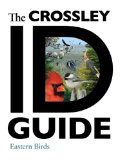
 I always look forward to getting the latest field guide. I like to see what new features and innovations the authors have incorporated. In that regard, this year’s new North American field guide – The Crossley ID Guide
I always look forward to getting the latest field guide. I like to see what new features and innovations the authors have incorporated. In that regard, this year’s new North American field guide – The Crossley ID Guide – will be a doozy. Crossley’s digitally created plates, incorporating photos of birds from many different angles and distances, are groundbreaking. Hopefully they will be useful as well.
– will be a doozy. Crossley’s digitally created plates, incorporating photos of birds from many different angles and distances, are groundbreaking. Hopefully they will be useful as well.
February 21, 2011; Princeton University Press
-
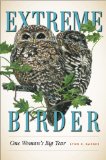
 I generally enjoy “big year” books, so Extreme Birder: One Woman’s Big Year
I generally enjoy “big year” books, so Extreme Birder: One Woman’s Big Year caught my eye. The author, Lynn Barber, is an ABA board member, and contributor to their blog.
caught my eye. The author, Lynn Barber, is an ABA board member, and contributor to their blog.
March 19, 2011; TAMU Press
-
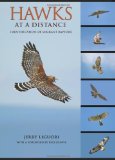
 Hawks at a Distance: Identification of Migrant Raptors
Hawks at a Distance: Identification of Migrant Raptors is Jerry Liguori’s followup to his excellent Hawks from Every Angle. According to the book’s description, this will be “the first volume to focus on distant raptors as they are truly seen in the field”. Sounds like a must-have for any hawk watcher.
is Jerry Liguori’s followup to his excellent Hawks from Every Angle. According to the book’s description, this will be “the first volume to focus on distant raptors as they are truly seen in the field”. Sounds like a must-have for any hawk watcher.
March 30, 2011; Princeton University Press
-

 Kenn Kaufman’s Advanced Birding has long been a required book for anyone wanting to come to grips with gulls, flycatchers, and other difficult-to-identify groups of North American birds. I’m sure his updated Kaufman Field Guide to Advanced Birding
Kenn Kaufman’s Advanced Birding has long been a required book for anyone wanting to come to grips with gulls, flycatchers, and other difficult-to-identify groups of North American birds. I’m sure his updated Kaufman Field Guide to Advanced Birding will be just as indispensable.
will be just as indispensable.
April 19, 2011; Houghton Mifflin Harcourt
-
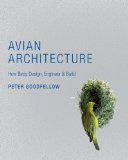
 After the Crossley guide, Peter Goodfellow’s Avian Architecture: How Birds Design, Engineer, and Build
After the Crossley guide, Peter Goodfellow’s Avian Architecture: How Birds Design, Engineer, and Build is probably the book I’m most looking forward to this year. How birds are able to build such marvelous structures has always been a mystery to me. I’ve been waiting a long time for a book that could explain and demonstrate the process. Hopefully that wait will be over shortly.
is probably the book I’m most looking forward to this year. How birds are able to build such marvelous structures has always been a mystery to me. I’ve been waiting a long time for a book that could explain and demonstrate the process. Hopefully that wait will be over shortly.
May 26, 2011; Princeton University Press
-
Just today I ran across this title – Binocular Vision: The Politics of Representation in Birdwatching Field Guides . The title piqued my curiosity; I had to find out what this was about. The publisher’s catalog says:
. The title piqued my curiosity; I had to find out what this was about. The publisher’s catalog says:
By putting field guides into direct conversation with concerns about species conservation, environmental management, the human alteration of the environment, and the problem of toxic pollution, Binocular Vision is a field guide to field guides that takes a
novel perspective on how we think about and interact with the world around us.
As someone who loves bird books and books about bird books, this sounds interesting to me.
July 31, 2011; University of Massachusetts Press
-
Arctic Autumn: A Journey to Season’s Edge
 is the third book in Pete Dunne’s series on season and place. The first two were great, but I’d be excited regardless because it’s Pete freakin’ Dunne!
is the third book in Pete Dunne’s series on season and place. The first two were great, but I’d be excited regardless because it’s Pete freakin’ Dunne!
September 21, 2011; Houghton Mifflin Harcourt
-
Last, but certainly not least, is the final volume in the landmark series – Handbook of the Birds of the World, Volume 16. This will be “the first work to verbally and visually portray each member of an entire Class of the Animal Kingdom”. I’m especially excited due to the families covered: Tanagers, Cardinals, Buntings and New World Sparrows, and New World Blackbirds.
October, 2011; Lynx Edicions
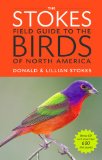
 For the fourth straight year there’s a new photographic field guide to North American birds. This latest one is by the well-known and highly regarded husband and wife duo of Donald and Lillian Stokes. I haven’t had a chance to really delve into it yet, but so far it’s pretty impressive. I’m planning on doing something different to give everyone a good look at it, but in the mean time, check out the reviews at 10,000 Birds and Birding is Fun!. There’s also a fantastic interview with the authors.
For the fourth straight year there’s a new photographic field guide to North American birds. This latest one is by the well-known and highly regarded husband and wife duo of Donald and Lillian Stokes. I haven’t had a chance to really delve into it yet, but so far it’s pretty impressive. I’m planning on doing something different to give everyone a good look at it, but in the mean time, check out the reviews at 10,000 Birds and Birding is Fun!. There’s also a fantastic interview with the authors.
If you’re anxious to get a copy, you can enter to win one through the 10,000 Birds Conservation Club. And if you don’t luck out there, be on the lookout here for a giveaway.
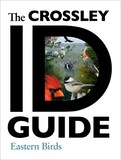 A while back, I wrote about a promising looking field guide that Richard Crossley was working on. Since then, Princeton University Press has announced that they will publish The Crossley ID Guide.
A while back, I wrote about a promising looking field guide that Richard Crossley was working on. Since then, Princeton University Press has announced that they will publish The Crossley ID Guide.
The guide isn’t coming out until next year, but some details have already been released, and now I really can’t wait to get my eyes on this thing. There are some excerpts and a great video interview with Crossley at Barnes and Noble.
It should be interesting, to say the least.


by David Allen Sibley
September 15, 2009; $39.95
Nine years ago, The Sibley Guide to Birds was published and quickly became generally regarded as the best North American field guide. And now Sibley turns his tremendous talent to a very different group of organisms.
The Birder’s World magazine blog has an excellent multi-part interview with Sibley. In it, he discusses why trees, the process of creating the guide, why birders will enjoy it, and much more. It’s a fascinating interview, and made me really look forward to the guide. Amazon also has a video interview.
also has a video interview.
I’m very excited about this, since I’ve been telling myself for some time that I need to learn trees better.
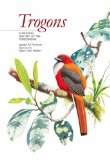

by Joseph M. Forshaw
I love trogons, and the description of this new book left me drooling:
This is the definitive natural history of the spectacularly beautiful tropical birds known as the trogons, a family that includes the legendary Resplendent Quetzal, the sacred bird of the ancient Mayans and Aztecs. A collaboration between renowned ornithologist Joseph Forshaw and eminent bird artist Albert Gilbert, Trogons combines science and art to create an unprecedented picture of a threatened bird family. Forshaw’s text provides the most authoritative and comprehensive account of the trogons ever written, and Gilbert’s stunning paintings are the first to accurately depict all species of trogons in their natural habitats and true colors. The book’s detailed synthesis of current knowledge about the trogons is enriched by Forshaw’s personal field observations in the tropical rainforests of Southeast Asia, Africa, and the Americas, while Gilbert’s meticulous artwork is based on fieldwork in the same areas. With its large format, more than 40 full-color plates, and state-of-the-art five-color printing, this limited-edition book promises to become a classic and a collector’s item.
However, there are some over at BirdForum that were leery of the artwork. After seeing a couple of sample plates, I can see why.
But I went ahead and ordered it anyway. The trogons are one of my favorite families, and I couldn’t resist. Additionally, this is a limited edition, with only 700 copies available in the U.S. and another 700 for the rest of the world. I hope publishers don’t read this, but I’m a sucker for limited editions.
As soon as I get this, I’ll post my initial thoughts as soon as I can. But in the meantime, if you think you will eventually want a copy, I would suggest ordering it sooner rather than later. Amazon currently shows only one left in stock. I have no idea if they will be receiving any more. But given how much it costs, I wouldn’t blame anyone from holding off until they can see it first!
I’ve been pretty busy lately and haven’t had enough time to write reviews. I’m hoping that will change soon. But in the meantime, here are some thoughts on some recently published bird books.
-
 Life List: A Woman’s Quest for the World’s Most Amazing Birds
Life List: A Woman’s Quest for the World’s Most Amazing Birds
Olivia Gentile
This is an excellent biography of uber-birder and lister Phoebe Snetsinger. I have already written a review of Birding on Borrowed Time, Phoebe’s memoir, and I was curious to see how this biography would compare. Briefly, in just about every regard, I consider this bio as superior. I would recommend starting with it.
-
 Birdscapes: Birds in Our Imagination and Experience
Birdscapes: Birds in Our Imagination and Experience
Jeremy Mynott
My favorite bird book from last year was The Life of the Skies. I’m less than 50 pages into Birdscapes, but so far it reminds me very much of Life of the Skies. It may touch upon some of the same subjects, but it’s really the way that it makes you question things, and really think. I’m going to make a bold prediction and say that this may be my frontrunner for favorite book of 2009 – I’m enjoying it that much so far.
-
 Birdsong by the Seasons: A Year of Listening to Birds
Birdsong by the Seasons: A Year of Listening to Birds
Donald Kroodsma
Kroodsma’s The Singing Life of Birds is fantastic, and should be required reading for anyone interested in bird song. This book, which is a celebration of birdsong from January to December, looks like it could be just as good.
is fantastic, and should be required reading for anyone interested in bird song. This book, which is a celebration of birdsong from January to December, looks like it could be just as good.
-
 Flyaway: How A Wild Bird Rehabber Sought Adventure and Found Her Wings
Flyaway: How A Wild Bird Rehabber Sought Adventure and Found Her Wings
Suzie Gilbert
A verteran bird rehabber chronicles her experiences with injured birds. This looks like an interesting story, all the more so because it’s a subject that is underrepresented in birding literature.
-
 National Geographic Complete Birds of the World
National Geographic Complete Birds of the World
This guide presents an account for each of the world’s bird families, similar to The Princeton Encyclopedia of Birds . I’ve only had a chance to skim through this one, but my initial impression is that if, given the choice, I’d take the one from Princeton.
. I’ve only had a chance to skim through this one, but my initial impression is that if, given the choice, I’d take the one from Princeton.
-
 The Travails of Two Woodpeckers: Ivory-Bills and Imperials
The Travails of Two Woodpeckers: Ivory-Bills and Imperials
Noel F. R. Snyder, David E. Brown, Kevin B. Clark
I believe the title says it all. Snyder has written books on several other extinct and endangered species, and I’m interested in his take on these two.

 The Art of Bird Finding: Before You ID Them, You Have to See Them
The Art of Bird Finding: Before You ID Them, You Have to See Them Binocular Vision: The Politics of Representation in Birdwatching Field Guides
Binocular Vision: The Politics of Representation in Birdwatching Field Guides





 A while back, I
A while back, I 











